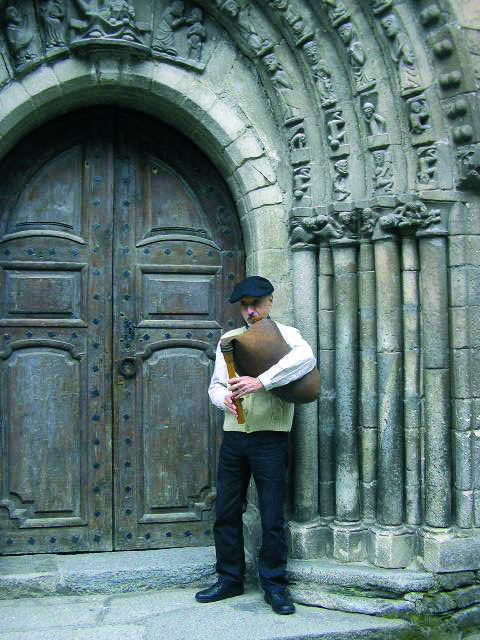The Bagpipe Society
Eth Bot d'Aran
Many of those attending the Blowout in May this year were entranced by the sound of a bagpipe made and played by Pierre Rouch. The bot has a haunting, open sound and is particularly suited to accompanying singing. It proved such a hit that I know several orders were placed with Pierre! Wanting to find out more about this instrument, I am particularly grateful to the maker, Bernat Ménétrier-Marcadal, who has contributed this article and to Pierre Rouch for sharing his personal reflections. Editor
Bernat Ménétrier-Marcadal:
“Eth Bot: whole skin leather bag - wine, oil, etc. container …” but it is also the name of the bagpipe(s) of the Aran Valley, according to the 1947 Gascony Linguistic Atlas.* As part of my work at the Conservatoire Occitan in Toulouse in the mid-70s, as well as relying on acquaintances knowledge, these were the only details I had to go from in my search for the instrument, since the women’s section of the fascist Falange still had full control over folk traditions in the Spanish State.

Unfortunately, these instruments disappeared and there were no surviving examples. Yet their memory remained alive in the memories of some witnesses. By gathering together some detailed explanations (with dimensions!) the result was one of the simplest tyes of primitive bagpipe and we were able to build a prototype.
What does this bagpipe look like? One of the first witnesses told me, in 1976, that it was like a clarinet without either the bell nor any keys and the pipe was attached to the neck of a wineskin, and the result was that the combination of these two elements made a bagpipe! All other witnesses confirmed this basic description, adding details of dimensions, sound and its associated customs. It was the cowherd’s instrument and he played it while walking or in the evening at mountain barns as well as to accompany the old traditional songs. Its low tone and open sound means that it is less suitable for dance music.
In the 1980s, thanks to the cultural policy of the Generalitat of Catalonia and the Museum of the Val d’Aran, the Bot has reappeared and today it is played on the streets, in churches, in houses and on the many paths of the valley …
Today, with a new generation eager to learn and revive its heritage in Aran, Comminges and Couserans, the Bot can once again brighten up celebrations, become the voice of the evenings by the fire place, and accompany the hikers in the mountains …
* The Aran Valley, or Val d’Aran, is situated right in the centre of the Pyrénées. The Garonne river has its source on the north slope of the valley. Occitan is the native language and culture even though it is actually situated in the Spanish state.
Bernat Ménétrier-Marcadal.
Further information about instruments of the area can be found at https://arrebrembar.wordpress.com/
Pierre Rouch
It all began in Saint Girons in the Couserans county when I was around ten years old. Eth Bot is definitely the very first bagpipe I had ever heard.
Therefore, Eth Bot simply had to be included in the Pyrenean shawms and bagpipes restoration project I was leading years later. It was in 2009 that, on Bernat Ménétrier’s advice, I started to study Eth Bot’s identity and morphology and felt a particular allegiance to the instrument since I live in a valley located near the very place where this instrument was allegedly played. Following Bernat’s explanations about the instrument symbolism, its origins and how and when it was played, we went to Aran to visit the historical sites and understand the artistic and cultural context. Once we had gathered all these elements I could, at last, get started making the instrument based on the information I had accumulated. The monoxyle reed is rather difficult to make but is very long lasting. Thanks to its bass tone Eth Bot can be played to accompany singing however neither octave nor subtonic are possible but since the majority of the ancient Pyrenean songs repertoire is played around a fifth, Eth Bot’s 7 notes suffice with their deep bass tones and rich harmonics.
This ancient bagpipe draws its richness and character from its utter simplicity. Let’s hope the Bot will enjoy a revival in Aran, Comminges and Couserans.
Pierre ROUCH
http://www.bouilleurdesons.fr/
If you wish to hear the haunting sound of the bot, then there is a video made of Trio Matta-Rouch at the Blowout on the Society’s YouTube site - http://tinyurl.com/ptpl3d5
- Data Processing Notice (GDPR)
-
@BagpipeSociety on X (formally known as Twitter)
-
TheBagpipeSociety on Instagram
-
 BagpipeSociety on Facebook
BagpipeSociety on Facebook
Something wrong or missing from this page? Let us know!
